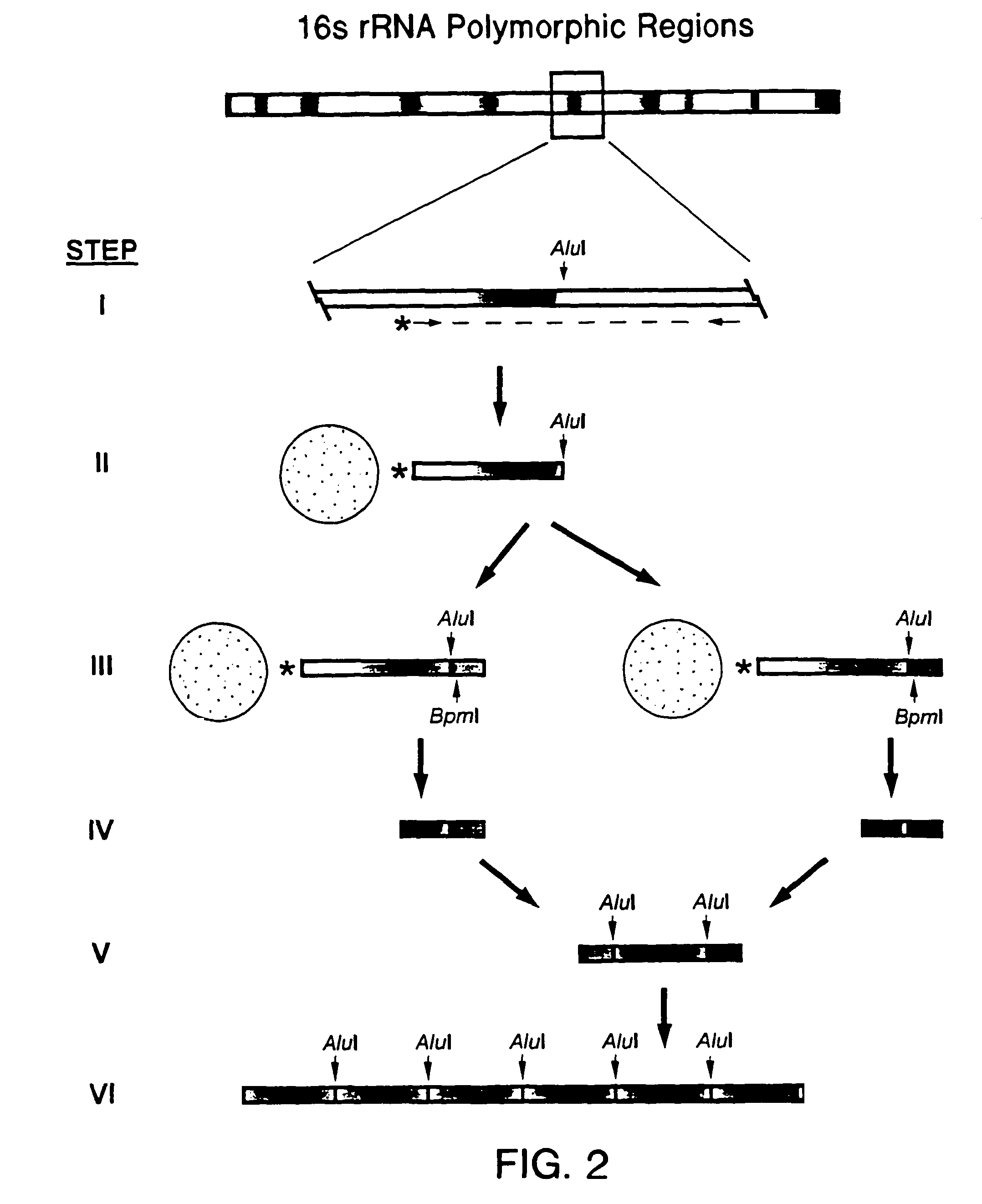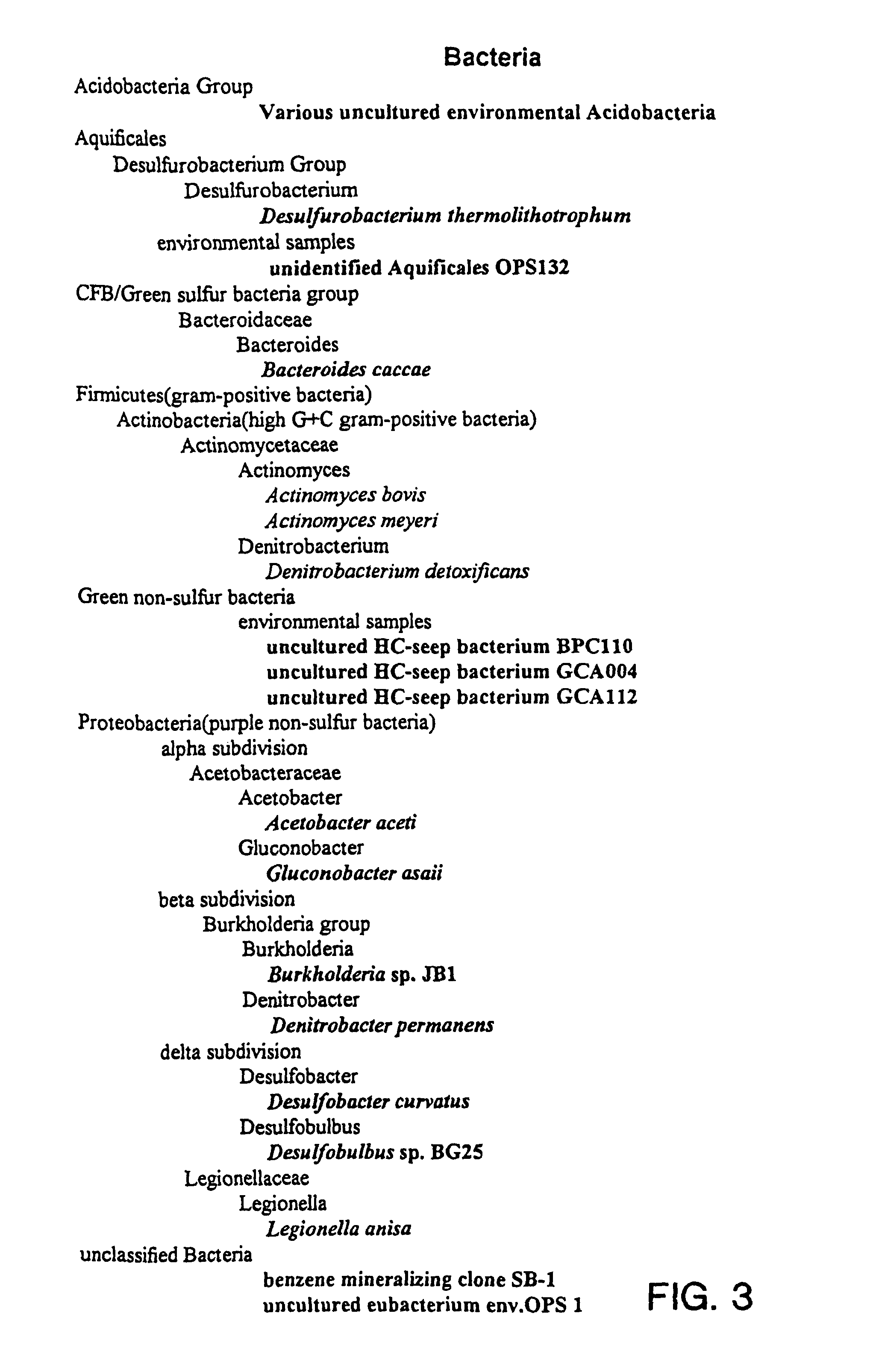DNA-based methods of geochemical prospecting
a geochemical and dna-based technology, applied in the field of dna-based geochemical prospecting, can solve the problems of limited approach, increased health problems of bacteria or fungi, microbial infections caused by bacteria or fungi, etc., and achieve the effect of quick “capture” and easy manipulation
- Summary
- Abstract
- Description
- Claims
- Application Information
AI Technical Summary
Benefits of technology
Problems solved by technology
Method used
Image
Examples
example 1
Serial Analysis of rDNA Polymorphic Tags from the Domain Eubacteria
[0108]A sample comprising environmental bacteria was obtained and total DNA was extracted from the sample. To, amplify the DNA, PCR was performed by mixing 5 μL 10×Advantage2 reaction buffer (Clontech), 2.5 μL dNTPs, 5 μL 8 μM TX9 / TX16 primers, 50 ng of sample DNA, 0.5 μL Advantage2 Taq polymerase (Clontech) and water to 50 μL. Primer TX9 was biotinylated. The primers are shown in FIG. 12 and a general strategy of this example is shown in FIG. 13. The reaction mixture was then subjected to PCR under the following conditions:
[0109]a) 94° C. for 5 minutes;
[0110]b) 94° C. for 1 minute, 10 seconds;
[0111]c) 55° C. for 50 seconds;
[0112]d) 68° C. for 1 minute;
[0113]e) repeat steps (b) through (d) 20 times; and
[0114]f) 68° C. for2minutes.
[0115]The approximately 600 basepair PCR product was gel purified using 1% agarose and a Qiaquick kit (Qiagen) according to manufacturer's instructions. The DNA was eluted with 50 μL Tris-ED...
example 2
SARD Analysis of a Defined Population
[0135]SARD was performed essentially as described in Example 1. In this example, commercially available bacterial genomic DNA samples were mixed at an equal concentration (weight / volume). The bacterial DNA samples used included Bacillus subtilis, Clostridium perfringens, Escherchia coli, Lactococcus lactis and Streptomyces coelicolor. Equal volumes of the DNA samples (total genomic DNA) were mixed at a concentration of 50 ng / μL each. Chart I shows the size of the genomes of each bacterial species, the number of 16S rDNA copies per genome and the molar percentage of 16S copies for each bacterial species in the total DNA sample.
[0136]
Chart IBacteriaGenome (Mb)16S Copies / GenomeMolar %B. subtilis4.21017.2C. perfringens4.41016.4E. coli4.6711.0L. lactis2.41030.7S. coelicolor8.065.4
[0137]After SARD, 120 tags were sequenced. Chart II shows the expected number and percentage of tags compared to the observed number and percentage of tags for the population...
example 3
SARD Analysis of Environmental Bacterial Diversity
[0140]In order to demonstrate that the SARD method could be used to survey environmental bacterial diversity, total DNA was extracted from two soil samples (Wy-1 and Wy-2) taken from the Rocky Mountain Oilfield Testing Center (RMOTC, Casper, Wyo.) in October, 2000. The samples were collected about 0.5 miles apart and from a depth of 14-18 inches. The environmental DNA samples were subjected to SARD analysis as described in Example 1. In a preliminary analysis, 148 tags were identified from Wy-1 and 234 tags were identified.fromr Wy-2 (FIGS. 15 and 16, respectively).
[0141]In the Wy-1 sample, 58 distinct tags were identified and the abundance of each tag varied. The most abundant tag (ATGGCTGTCGTCAGCT) (SEQ ID NO: 6) made up about 34% of the population. This tag sequence is identical to many bacterial sequences in GenBank and its position within the 16S rDNA gene indicates that it is located in a conserved region located distal to the ...
PUM
| Property | Measurement | Unit |
|---|---|---|
| temperatures | aaaaa | aaaaa |
| depths | aaaaa | aaaaa |
| depths | aaaaa | aaaaa |
Abstract
Description
Claims
Application Information
 Login to View More
Login to View More - R&D
- Intellectual Property
- Life Sciences
- Materials
- Tech Scout
- Unparalleled Data Quality
- Higher Quality Content
- 60% Fewer Hallucinations
Browse by: Latest US Patents, China's latest patents, Technical Efficacy Thesaurus, Application Domain, Technology Topic, Popular Technical Reports.
© 2025 PatSnap. All rights reserved.Legal|Privacy policy|Modern Slavery Act Transparency Statement|Sitemap|About US| Contact US: help@patsnap.com



